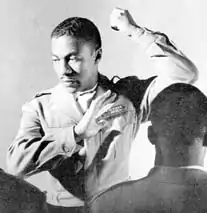Leonard De Paur | |
|---|---|
 De Paur conducting | |
| Background information | |
| Born | November 18, 1914 Summit, New Jersey, United States |
| Died | November 7, 1998 (aged 83) Manhattan, New York, United States |
| Genres | |
| Occupation(s) | Choral director, composer, conductor |
| Years active | 1936–1988 |
| External audio | |
|---|---|
Leonard Etienne De Paur (November 18, 1914 – November 7, 1998) was an American composer, choral director, and arts administrator.
Early life
Leonard De Paur was born in Summit, New Jersey to Hettie Carson de Paur and Ernst Leonard.[1] He moved to Jersey City with his mother, after his parents separated, and attended the local public schools.[2] His musical studies began at the Manual Training Institute in Bordentown, New Jersey, where he played oboe and saxophone.[2][3] He attended with Frederick Work, brother of John Wesley Work II and uncle of John Wesley Work III.
Career
De Paur began to compose and arrange while he was a member of the Hall Johnson Choir. He sang in the baritone section and served as assistant conductor alongside Jester Hairston. In 1936, De Paur became the musical director of the Negro Unit of the Federal Theater Project in New York City.[2] During this time he was also enrolled at Columbia University and later went on to study at the Institute of Musical Arts, now the Juilliard School.
In 1941 he collaborated with the conductor Alexander Smallens and the orchestral accordionist John Serry Sr. in an oratorio production of Virgil Thomson's opera Four Saints in Three Acts at New York City's Town Hall.[4] De Paur enlisted in the United States Army Air Forces in 1942, was promoted to Lieutenant, and became the music director of the play Winged Victory.[5] During a stint in the infantry, he was assigned to an all male-chorus.[6] The De Paur Infantry Chorus was made up of 35 men from the 372nd Glee Club. Their performances consisted of art song repertory, Caribbean folk music, spirituals, work songs and military songs. In 1946, the De Paur Infantry Chorus was signed to Columbia Artists Management and Columbia Records. The chorus now consisted of men from the 372nd Glee Club, other branches of Armed services, and civilians. For ten years the De Paur Infantry Chorus was the top performing group at Columbia. In 1957, De Paur discontinued the chorus and produced the De Paur Opera Gala, which featured Virgil Thomson's Four Saints in Three Acts, George Gershwin's Porgy and Bess and Oscar Hammerstein's Carmen Jones.
In the early 1960s, the De Paur Chorus was formed to tour 18 African nations under the United States Information Agency.[2] Shortly after the chorus disbanded in 1968, De Paur became the associate director of the Lincoln Center International Choral Festival. A few years later he was named the director of community relations. He created the Lincoln Center Out-of-Doors Festival[7] and the Community Holiday Concert Series. He retired from the Lincoln Center in 1988.
During his career De Paur received honorary Doctor of Music degree from Lewis and Clark College. He was the recipient of the University of Pennsylvania Glee Club Award of Merit and an honorary member of the Morehouse College Glee Club.[8]
De Paur died in Manhattan on November 7, 1998.
References
- ↑ Tommasini, Anthony. "Leonard de Paur Dies at 83; Lincoln Center Administrator", The New York Times, November 11, 1998. Accessed February 19, 2011. "Mr. de Paur used to say there was never a time when he could not remember wanting to be a musician. He was born in Summit, N.J., on Nov. 18, 1914. And though his father, a lawyer active in local politics, was at first dismayed by his son's choice of career, both of Mr. de Paur's parents were music lovers."
- 1 2 3 4 Woods, Timothy Erickson. Leonard de Paur's arrangements of spirituals, work songs, and African songs as contributions to choral music: A black choral musician in the mid-twentieth century, University of Arizona, 1998. Accessed March 7, 2023. "Born in Summit, New Jersey, de Paur attended the Nixon School and Lincoln School. His parents separated, and with his mother, Hettie (Carson) de Paur, he moved to Jersey City, where she had relatives. He attended PS34 at Clairmont and Rose, and later attended PS 14 on Union St.... Leonard de Paur began his music studies at the Manual Training Institute at Bordentown, New Jersey, a military academy and industrial school. He played saxophone and oboe in the band, sang in the glee club, and took theory lessons."
- ↑ Turner, Patricia. Dictionary of Afro-American Performers: 78 RPM and Cylinder Recordings of Opera, Choral Music, and Songs, c1900-1949. 1990
- ↑ New York Times 28 May 1941 P. 32
- ↑ Southern, Eileen. The Music of Black Americans: A History. W. W. Norton & Company; 3rd edition.
- ↑ Abdul, Raoul. Blacks in Classical Music: a Personal History. New York: Dood, Mead,& Company, 1977. 210-211.
- ↑ Lincoln Center for the Performing Arts, Inc Archived 2011-07-17 at the Wayback Machine
- ↑ OFFICIAL Morehouse College Glee Club Website
External links
- Guide to the Collection of De Paur Chorus Materials, Center of Black Music Research, Columbia College Chicago
- Beware of Pretty Chords
- Leonard De Paur's Obituary in Opera News (February 1, 1999)